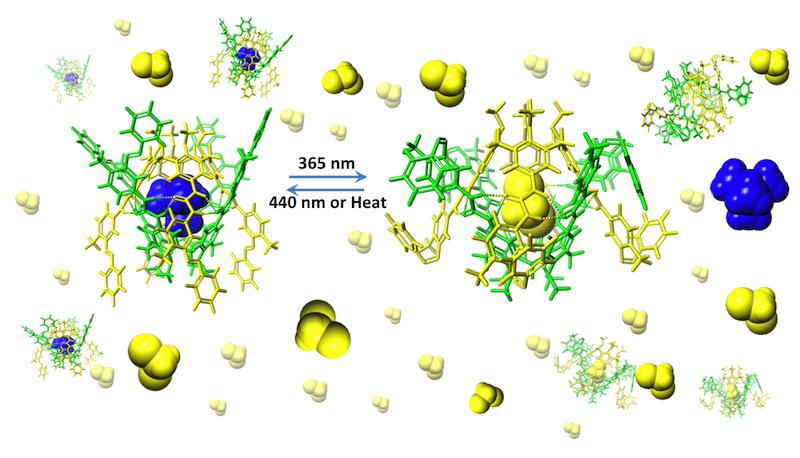Dimeric capsules controlled by light irradiation
The research group of Prof. Pau Ballester has developed a series of dimeric capsules whose equilibrium can be controlled by light irradiation leading to the total or partial release of the guest molecule. The switching between the two states can be repeated multiple times with no detectable photodegradation.
Molecular containers are chemical structures capable of encapsulate other molecules (guest molecule) inside a cavity. In general, molecules inside containers behave quite differently from those in solution because they are prevented from contacting other molecules that they might otherwise react with. Supramolecular containers are those in which the cavity is formed by assembled structures through metal/ligand interactions, hydrogen bonds or hydrophobic forces. The nature of the interactions is key in controlling the dynamics by which molecules can enter and leave its cavity. One of the challenges in this area is the direct control of the assembly-disassembly process of supramolecular capsules by light. Ideally, the assembly-disassembly process should correspond with the encapsulation-release of the guest molecule, which is a process of great interest in various fields such as the transport and controlled release of drugs, proteins, etc.
In this context, Prof. Ballester group has published a work in which they design and synthesize heterodimeric capsules self-assembled from tetraurea calix[4]pyrrole and tetraurea calix[4]arene for the inclusion of small polar molecules. They have introduced azobenzene units in the structure so that the isomerization of the trans-form of the azobencene to the cis-form upon light irradiation allows for the disassembly of the capsule and the partial release of the guest molecule to the solution. Among the guest molecules used in this studio stand out the N-oxides. N-oxides are a motif in some drugs but the main problem to use them in medicine is that they are rapidly degraded inside the human body so that it is difficult for them to reach the right place. The use of suitable nanocontainers capable of a controlled release of the drug could solve this problem.

Modification of the equilibrium state of the heterodimeric capsules system by light irradiation

Reversible light-controlled cargo release in dimeric capsules
In the same line of research, they published last year a paper in which they developed dimeric capsules formed by tetraurea calix[4]arene derivatives equipped with azobenzene groups. As indicated previously, azobenzene groups are photochromic groups that experience a significant change in shape –trans to cis form- upon light irradiation. This change in shape leads to the controlled disassembly of the capsule and the partial release of the guest molecule to the solution.
New results in this field of research will be discussed next October (17-20) in the ICREA Conference on Funcional Nanocontainers that will take place in Tarragona. Prof. Ballester is part of the scientific and organizing committees of this conference which will bring together leading international scientists representing various disciplines to present the results of their studies on fabrication, structural characterization, function and performance of nanometer-sized and/or nanostructured materials serving as containers, reactors or carriers of functional compounds.
References:
Moving systems of polar dimeric capsules out of thermal equilibrium by light irradiation
A. Diaz-Moscoso, F. A. Arroyave, P. Ballester
Chem. Commun., 2016, 52, 3046-3049
Reversible Light-Controlled Cargo Release in Hydrogen-Bonded Dimeric Capsules
F. A. Arroyave, P. Ballester
J. Org. Chem., 2015, 80, 10866-10873
Related news

Let's create a brighter future
Join our team to work with renowned researchers, tackle groundbreaking
projects and contribute to meaningful scientific advancements






 30-10-2024
30-10-2024 


















